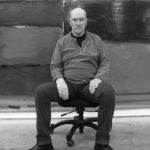Scully, Sean

Sean Scully (Dublin, 1945) is considered one of the most influential painters within geometric abstract expressionism, as well as minimalism, above all for creating a very particular language. His work has been exhibited in the most important museums in the world, including the Jeu de Paume National Gallery, the Albertina Museum in Vienna, the Metropolitan Museum of Art in New York, etc.
His interest in painting began very early through religious representations in churches, then he discovered Vincent Van Gogh's \"La chaise\" at the Tate Modern in 1960. These early encounters with art inspired him and encouraged his enrolment at Croydon College of Art.
Although he was born in Dublin, he moved to London at the age of four. He studied art at Croydon College of Art in the English capital and at Newcastle University. In 1975 he travelled to the United States where he taught at Princeton University in New Jersey until 1983, when he became a US citizen and also won a Guggenheim Fellowship. His first solo exhibition was held at the Rowan Galley in London in 1973.
From the beginning of his career, Sean Scully has worked on the basis of geometry.
As for his pictorial references, he makes no secret of his admiration for Matisse, Mondrian and Rothko, although the American Abstract Expressionist Jasper Johns and the Minimalists Reinhardt and Sol Le Wit are also important to him. Scully's painting revolves around feelings and emotions, or, in other words, the human spirit. For him, \"painting has the ability to synthesise the sense of the soul\", and he does this in practice by fusing colour with composition, which is why his paintings resemble landscapes.
In the 1980s, Scully began to incorporate into his compositions different pieces that he paints independently, which reinforces the spatial tension of his characteristic structure of vertical and horizontal bands; he thus plays with the trompe l'oeil that provokes the sensation of moving forward and backward in parts of the work, enhanced by the variation of the colours.
In New York he met minimalist artists such as Robert Ryman, who encouraged him to simplify his compositions. Subsequently he began to use mainly neutral colours. He also experimented with etching, pastel, watercolour and painting after nature, but is mainly known for his abstract panels with overlapping layers of paint, refined stripes and chessboards, inspired by the mutations of Irish society.

